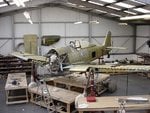its an old one, fw190 wreck in a forest in russia ,my favorite wreck video on the net most of you all ready seen it.
View: https://www.youtube.com/watch?v=OwZk7NtQMbI
fw190 under restoraition , liked it better in the state it was found..... original rlm colours
, liked it better in the state it was found..... original rlm colours
View: https://www.youtube.com/watch?v=OwZk7NtQMbI
fw190 under restoraition
Attachments
Last edited:

